Foreword / YouTube Video Review
The review on this website is a brief overview and summary of the objective performance of this speaker. It is not intended to be a deep dive. Moreso, this is information for those who prefer “just the facts” and prefer to have the data without the filler.
However, for those who want more - a detailed explanation of the objective performance, and my subjective evaluation (what I heard, what I liked, etc.) - please watch the below video where I go more in-depth.
Information and Photos
Note: Neumi sent me this speaker to test. I was not paid for this review nor has Neumi seen this review before publication.
The Neumi BS5P is a powered 2-way Studio Monitor featuring a 5-inch midwoofer and 1-inch dome tweeter. It comes with a variety of hookup options (Bluetooth, optical toslink, and RCA connections. It also comes with a remote control. The below is from the manufacturer’s website:
The BS5P is a powered bookshelf speaker designed for the budget-conscious music lover who wants a pair of simple, affordable, yet great sounding speakers. With classic styling cues, the BS5P is attractive yet unassuming, making it a great fit for the home, office, or garage. Play music wirelessly from your smartphone or computer to the BS5P using Bluetooth! Low-latency technology minimizes lip-sync issues when watching videos. Other inputs include optical and coaxial digital inputs for use with a TV, DVD/BD player, or game console. The analog input can be used with any analog source, including record players that have a built-in phono amp. With 75 watts of clean total power, the BS5P can fill a small to medium-sized room with high fidelity sound. Its capable DSP sound processing engine has been optimized for a smooth frequency response while limiting distortion at high sound levels. Convenient full-function remote for changing volume, switching between available inputs, and music playback control in Bluetooth mode. Based on the well-reviewed BS5 passive bookshelf speakers, the BS5P uses the same 5-inch fiberglass woofer and 1-inch silk dome tweeter. This design combination has been tuned to offer a good balance of bass output, midrange transparency, and treble smoothness. The result is music full of dynamic impact, accurate detail, and precise imaging.
As stated in the above, this is a powered version of the Neumi BS5 passive bookshelf speaker set, which I also reviewed here.
MSRP is about $150 USD for a pair.
And here are some specs copied from the manual:
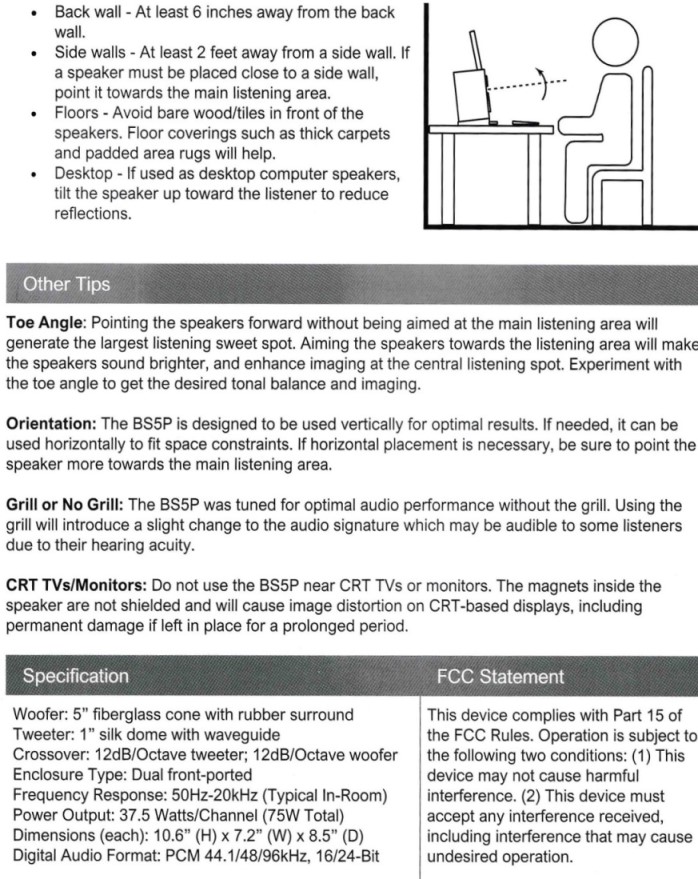
The front can be covered with a grille. The back features various inputs as well as buttons for power, source selection and volume/track selection. And a remote is also included.
CTA-2034 (SPINORAMA) and Accompanying Data
All data collected using Klippel’s Near-Field Scanner. The Near-Field-Scanner 3D (NFS) offers a fully automated acoustic measurement of direct sound radiated from the source under test. The radiated sound is determined in any desired distance and angle in the 3D space outside the scanning surface. Directivity, sound power, SPL response and many more key figures are obtained for any kind of loudspeaker and audio system in near field applications (e.g. studio monitors, mobile devices) as well as far field applications (e.g. professional audio systems). Utilizing a minimum of measurement points, a comprehensive data set is generated containing the loudspeaker’s high resolution, free field sound radiation in the near and far field. For a detailed explanation of how the NFS works and the science behind it, please watch the below discussion with designer Christian Bellmann:
A picture of the setup in my garage:
The reference plane in this test is just below the tweeter, per the manufacturer. A single RCA input was used and the volume was set to default. No grille was used and the ports were open (not stuffed).
Measurements are provided in a format in accordance with the Standard Method of Measurement for In-Home Loudspeakers (ANSI/CTA-2034-A R-2020). For more information, please see this link.
CTA-2034 / SPINORAMA:
The On-axis Frequency Response (0°) is the universal starting point and in many situations it is a fair representation of the first sound to arrive at a listener’s ears.
The Listening Window is a spatial average of the nine amplitude responses in the ±10º vertical and ±30º horizontal angular range. This encompasses those listeners who sit within a typical home theater audience, as well as those who disregard the normal rules when listening alone.
The Early Reflections curve is an estimate of all single-bounce, first-reflections, in a typical listening room.
Sound Power represents all the sounds arriving at the listening position after any number of reflections from any direction. It is the weighted rms average of all 70 measurements, with individual measurements weighted according to the portion of the spherical surface that they represent.
Sound Power Directivity Index (SPDI): In this standard the SPDI is defined as the difference between the listening window curve and the sound power curve.
Early Reflections Directivity Index (EPDI): is defined as the difference between the listening window curve and the early reflections curve. In small rooms, early reflections figure prominently in what is measured and heard in the room so this curve may provide insights into potential sound quality.
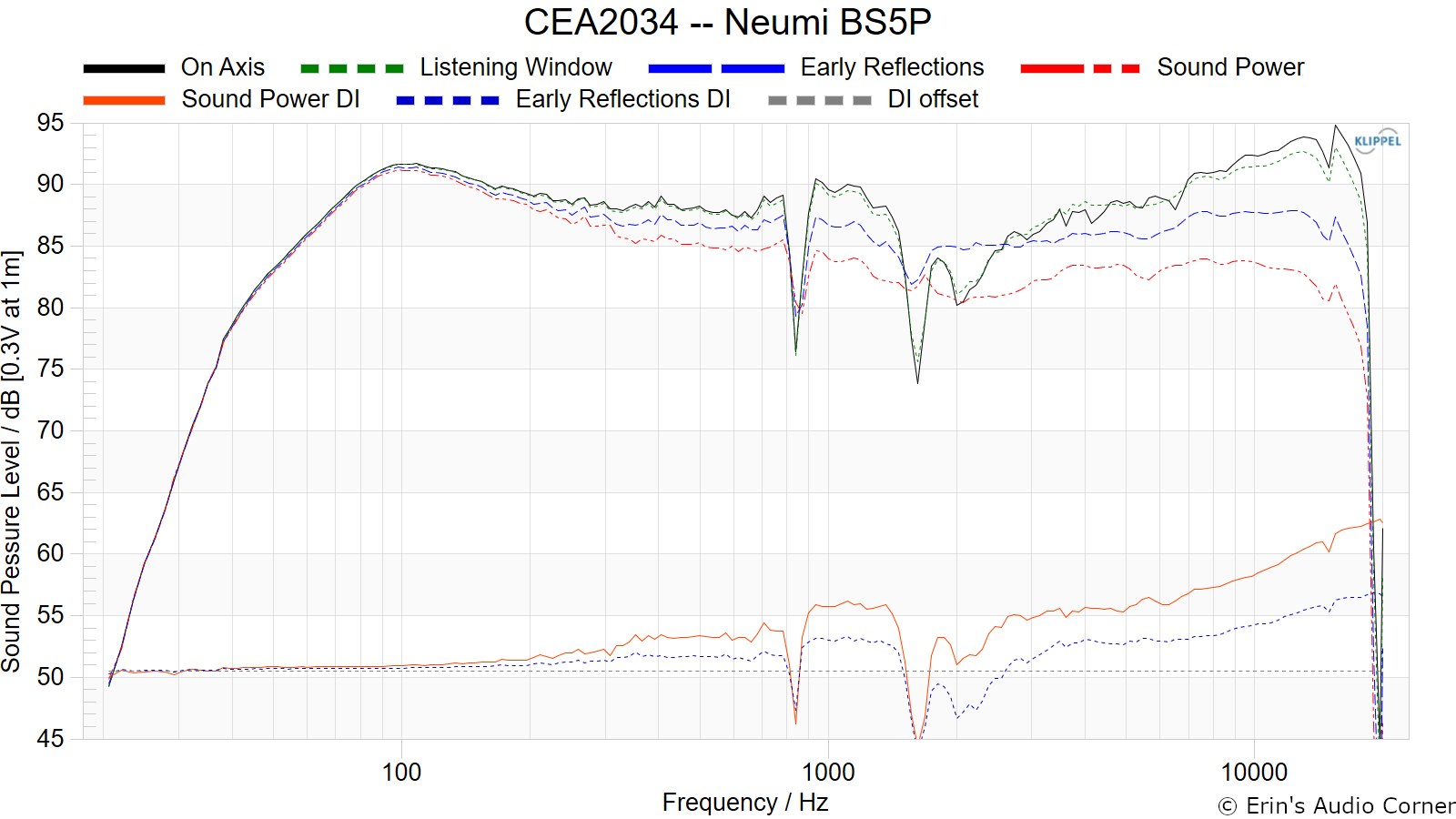
Early Reflections Breakout:
Floor bounce: average of 20º, 30º, 40º down
Ceiling bounce: average of 40º, 50º, 60º up
Front wall bounce: average of 0º, ± 10º, ± 20º, ± 30º horizontal
Side wall bounces: average of ± 40º, ± 50º, ± 60º, ± 70º, ± 80º horizontal
Rear wall bounces: average of 180º, ± 90º horizontal
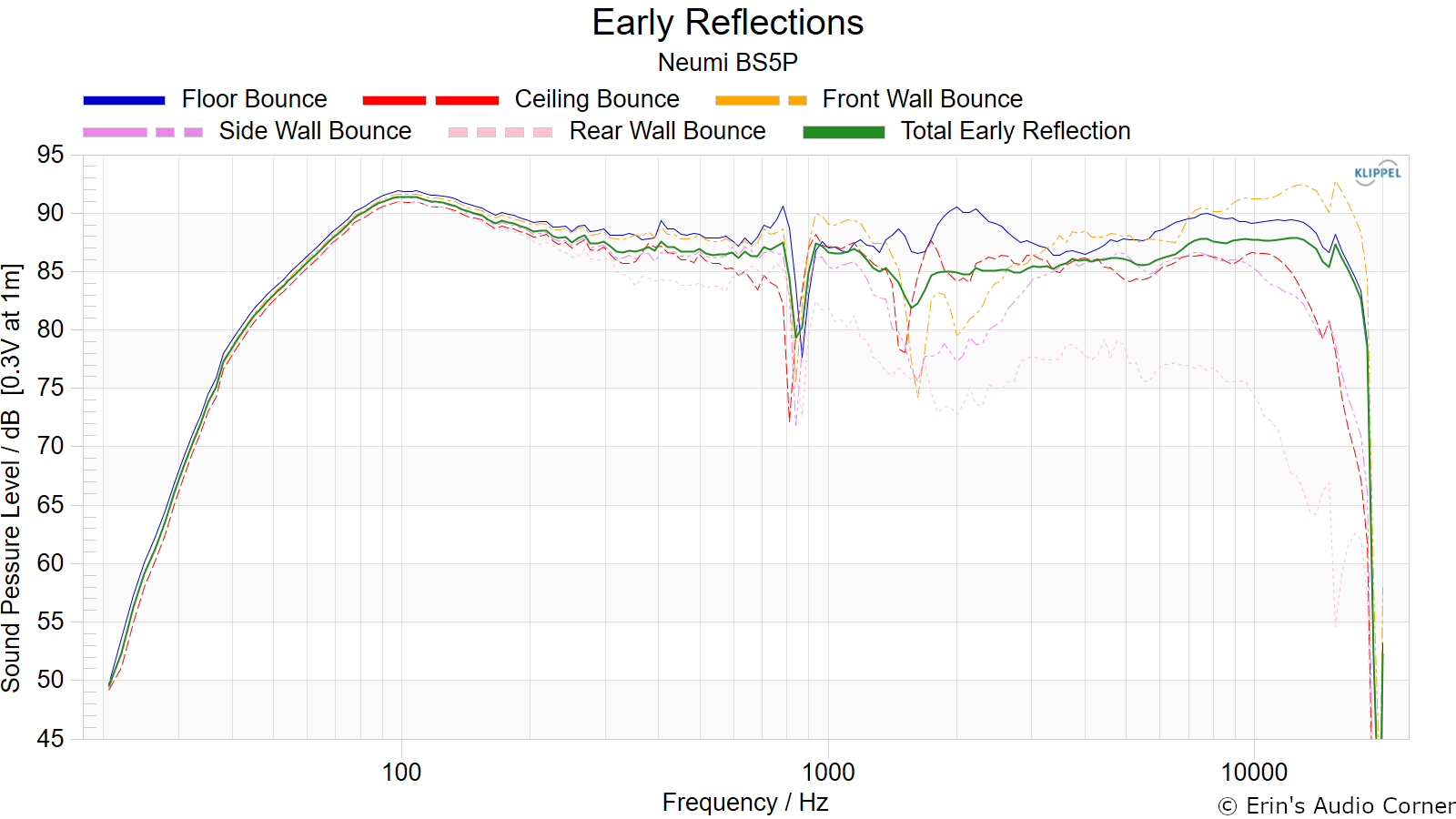
Estimated In-Room Response:
In theory, with complete 360-degree anechoic data on a loudspeaker and sufficient acoustical and geometrical data on the listening room and its layout it would be possible to estimate with good precision what would be measured by an omnidirectional microphone located in the listening area of that room. By making some simplifying assumptions about the listening space, the data set described above permits a usefully accurate preview of how a given loudspeaker might perform in a typical domestic listening room. Obviously, there are no guarantees because individual rooms can be acoustically aberrant. Sometimes rooms are excessively reflective (“live”) as happens in certain hot, humid climates, with certain styles of interior décor and in under-furnished rooms. Sometimes rooms are excessively “dead” as in other styles of décor and in some custom home theaters where acoustical treatment has been used excessively. This form of post processing is offered only as an estimate of what might happen in a domestic living space with carpet on the floor and a “normal” amount of seating, drapes, and cabinetry.
For these limited circumstances it has been found that a usefully accurate Predicted In-Room (PIR) amplitude response, also known as a “room curve” is obtained by a weighted average consisting of 12 % listening window, 44 % early reflections and 44 % sound power. At very high frequencies errors can creep in because of excessive absorption, microphone directivity, and room geometry. These discrepancies are not considered to be of great importance.

Horizontal Frequency Response (0° to ±90°):

Vertical Frequency Response (0° to ±40°):
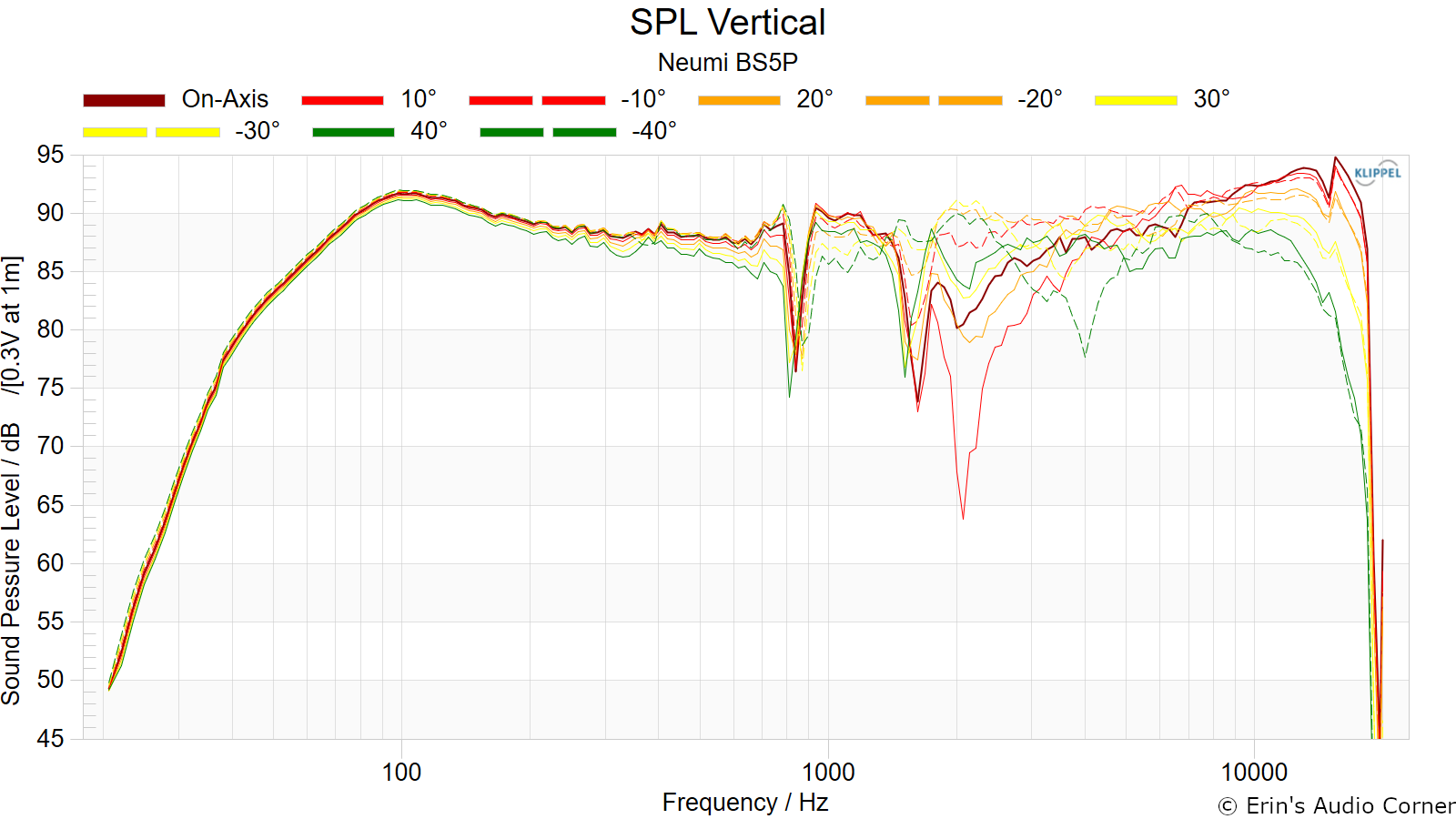
Horizontal Contour Plot (not normalized):

Horizontal Contour Plot (normalized):
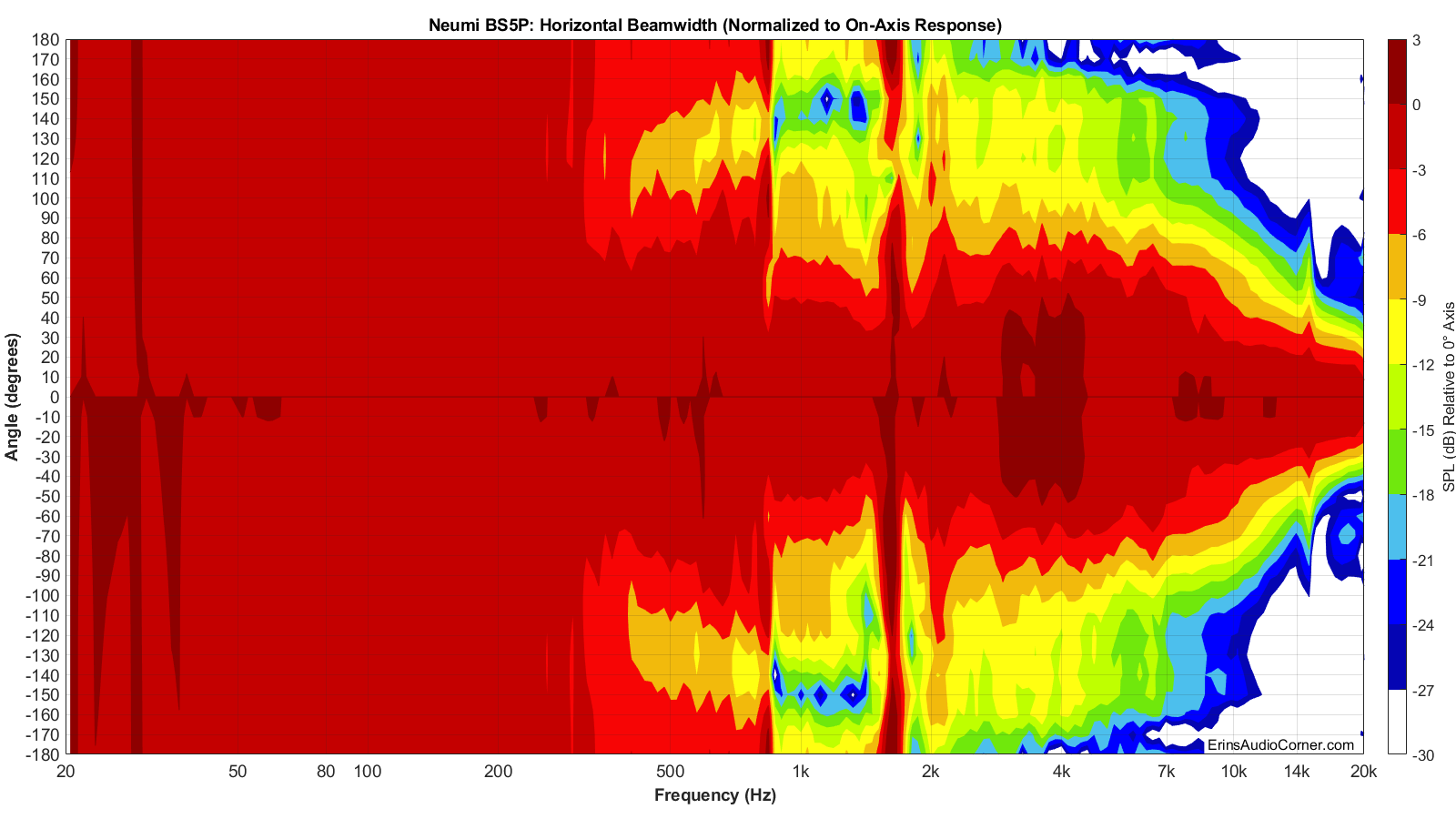
Vertical Contour Plot (not normalized):
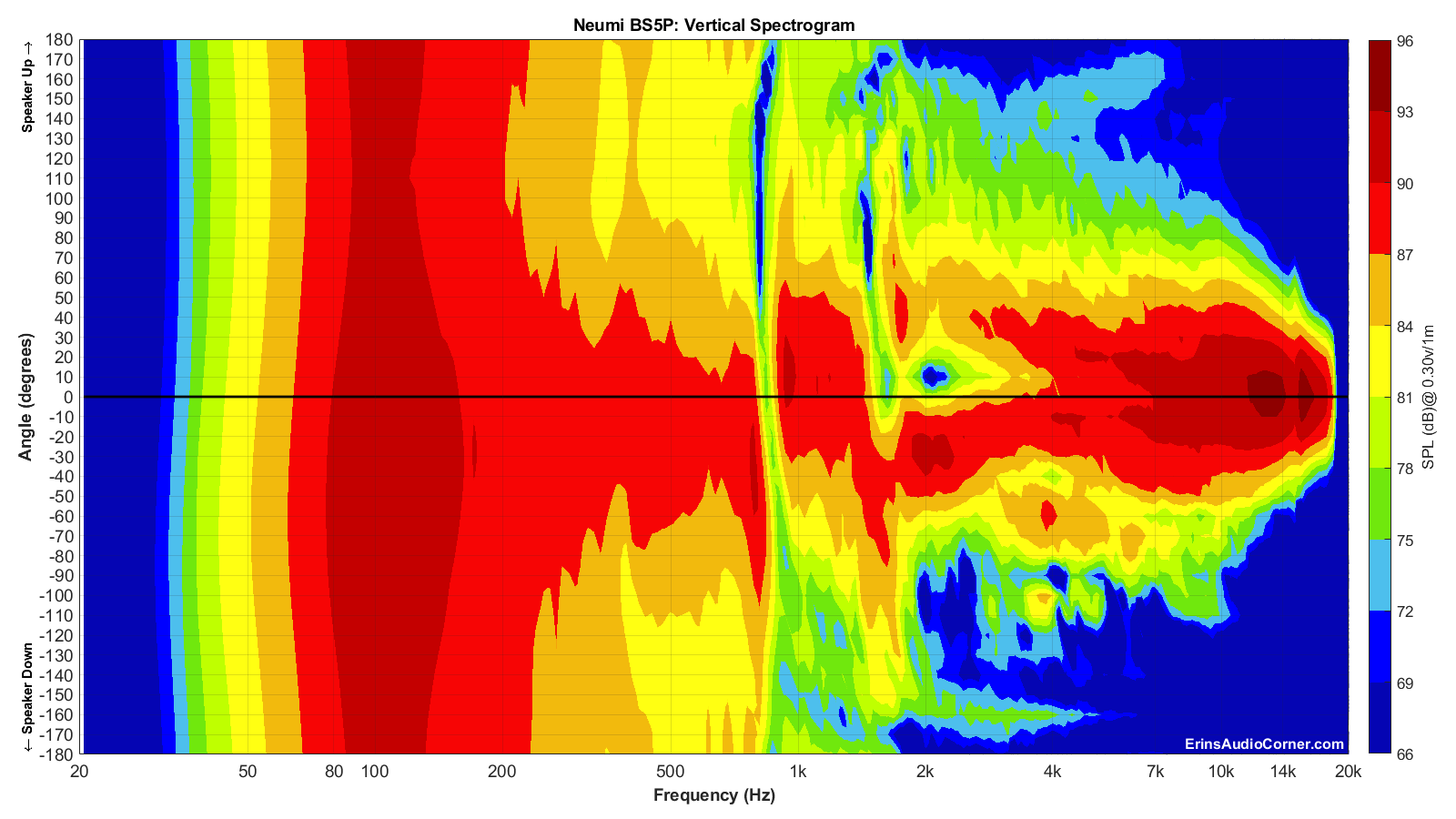
Vertical Contour Plot (normalized):
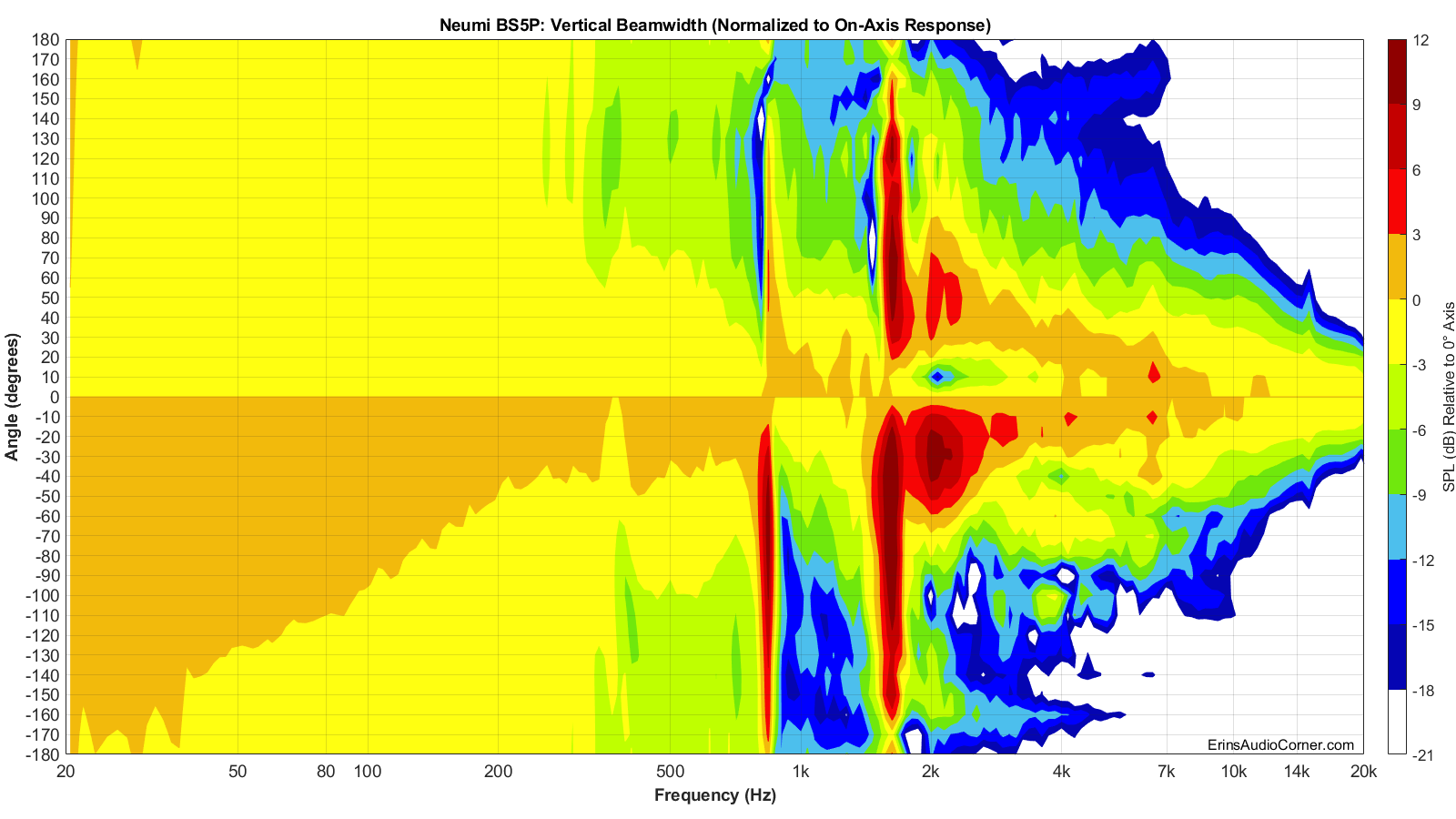
Additional Measurements
On-Axis Response Linearity
Response linearity is -12.44/+8.54 dB (80Hz to 16kHz).
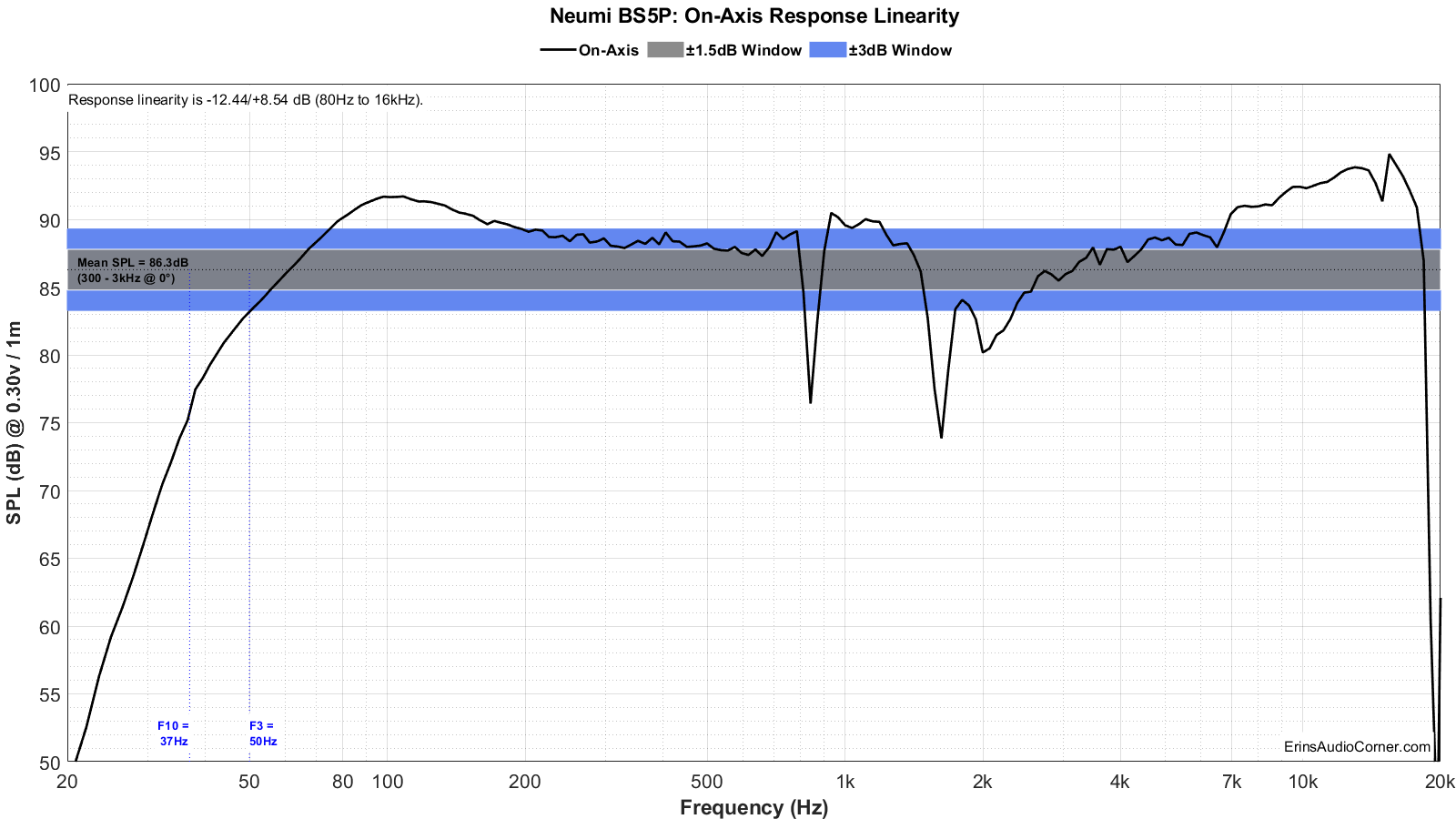
“Globe” Plots
These plots are generated from exporting the Klippel data to text files. I then process that data with my own MATLAB script to provide what you see. These are not part of any software packages and are unique to my tests.
Horizontal Polar (Globe) Plot:
This represents the sound field at 2 meters - above 200Hz - per the legend in the upper left.

Vertical Polar (Globe) Plot:
This represents the sound field at 2 meters - above 200Hz - per the legend in the upper left.

Harmonic Distortion
Harmonic Distortion at 86dB @ 1m:
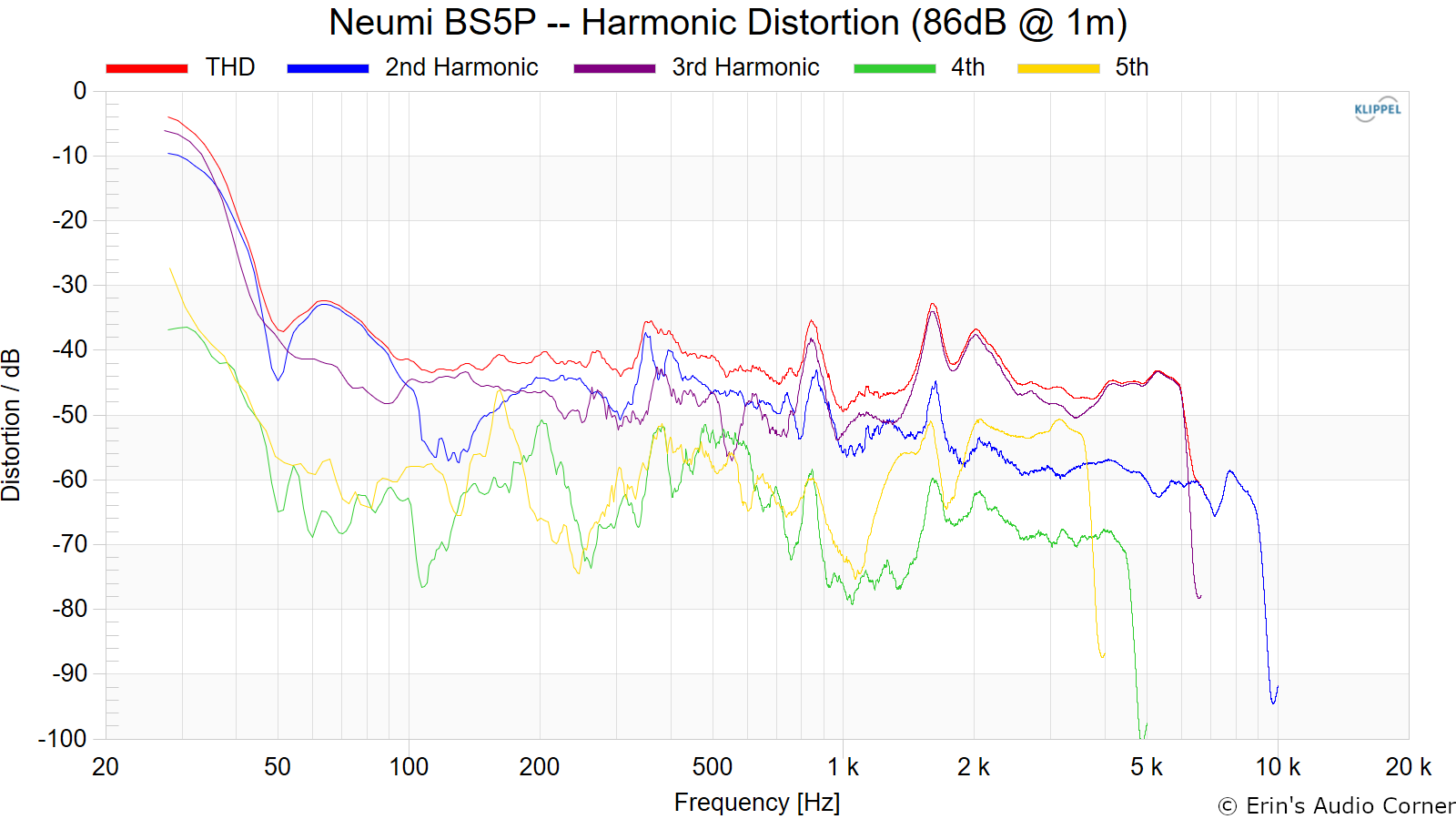
Harmonic Distortion at 96dB @ 1m:
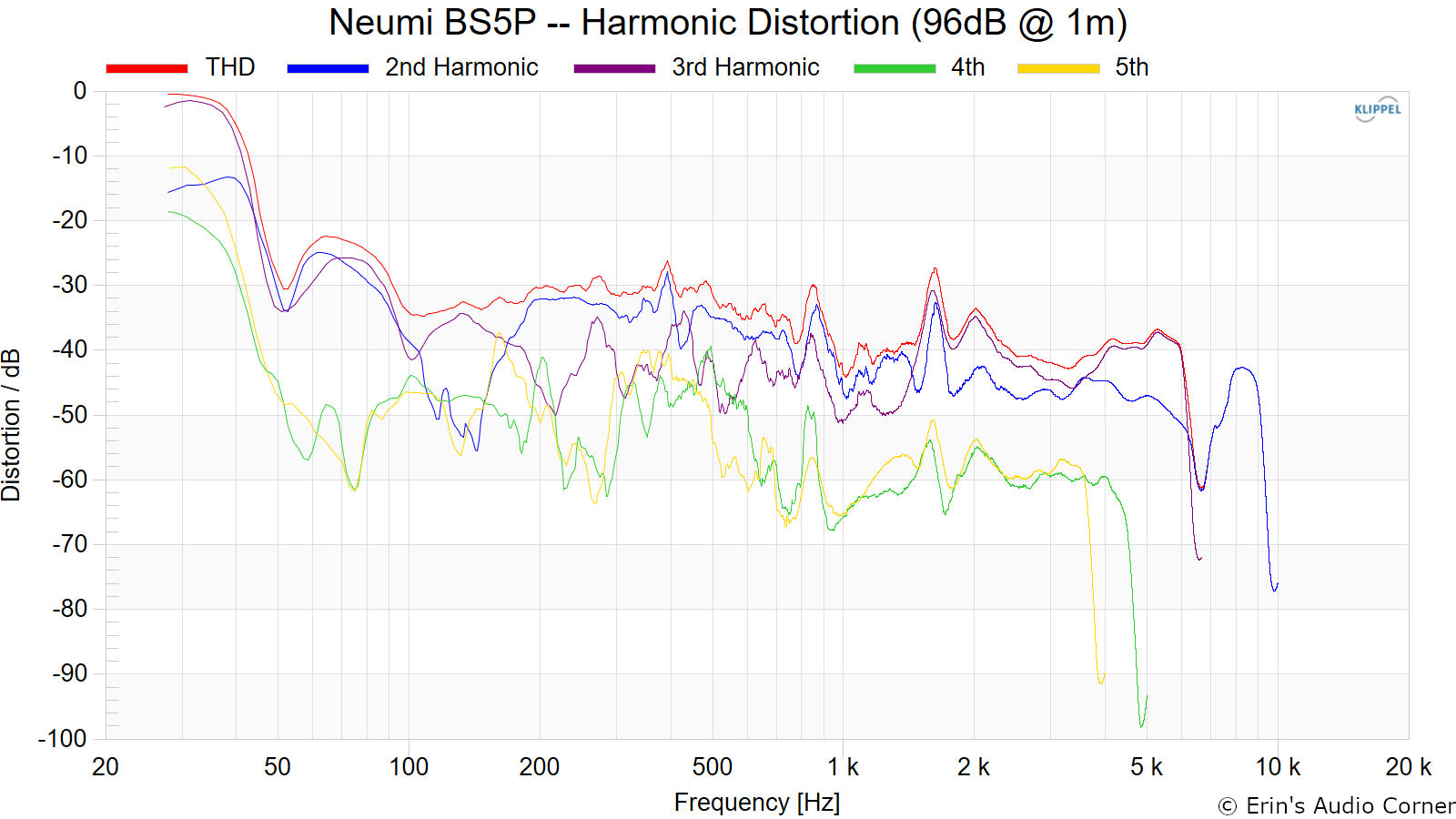
Near-Field Response
Nearfield response of individual drive units:

Dynamic Range (Instantaneous Compression Test)
The below graphic indicates just how much SPL is lost (compression) or gained (enhancement; usually due to distortion) when the speaker is played at higher output volumes instantly via a 2.7 second logarithmic sine sweep referenced to 76dB at 1 meter. The signals are played consecutively without any additional stimulus applied. Then normalized against the 76dB result.
The tests are conducted in this fashion:
- 76dB at 1 meter (baseline; black)
- 86dB at 1 meter (red)
- 96dB at 1 meter (blue)
- 102dB at 1 meter (purple)
The purpose of this test is to illustrate how much (if at all) the output changes as a speaker’s components temperature increases (i.e., voice coils, crossover components) instantaneously.

Based on my results above, it is obvious the output is limited significantly somewhere above the 96dB @ 1m output level. I haven’t confirmed with Neumi if this is a built-in limiter, though, I assume it is.
Long Term Compression Tests
The below graphics indicate how much SPL is lost or gained in the long-term as a speaker plays at the same output level for 2 minutes, in intervals. Each graphic represents a different SPL: 86dB and 96dB both at 1 meter.
The purpose of this test is to illustrate how much (if at all) the output changes as a speaker’s components temperature increases (i.e., voice coils, crossover components).
The tests are conducted in this fashion:
- “Cold” logarithmic sine sweep (no stimulus applied beforehand)
- Multitone stimulus played at desired SPL/distance for 2 minutes; intended to represent music signal
- Interim logarithmic sine sweep (no stimulus applied beforehand) (Red in graphic)
- Multitone stimulus played at desired SPL/distance for 2 minutes; intended to represent music signal
- Final logarithmic sine sweep (no stimulus applied beforehand) (Blue in graphic)
The red and blue lines represent changes in the output compared to the initial “cold” test.

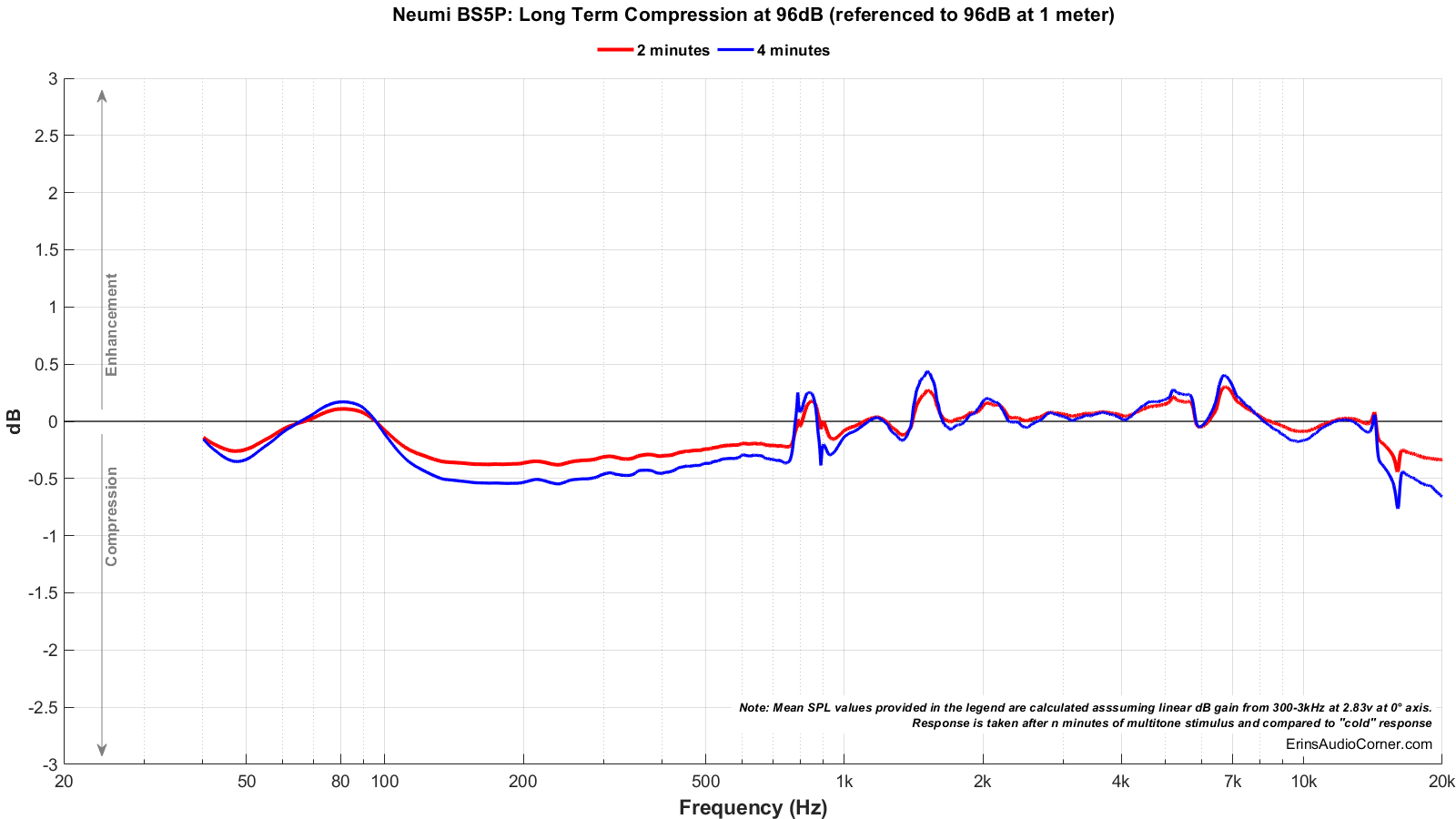
Neumi BS5P vs BS5 (Powered vs Passive version)
Below is the on-axis response comparison of the BS5P and the previous passive BS5 I tested in June 2020. You can see the updated BS5P has a definite “V-curve” response to it, putting more emphasis on the midbass and high frequencies.
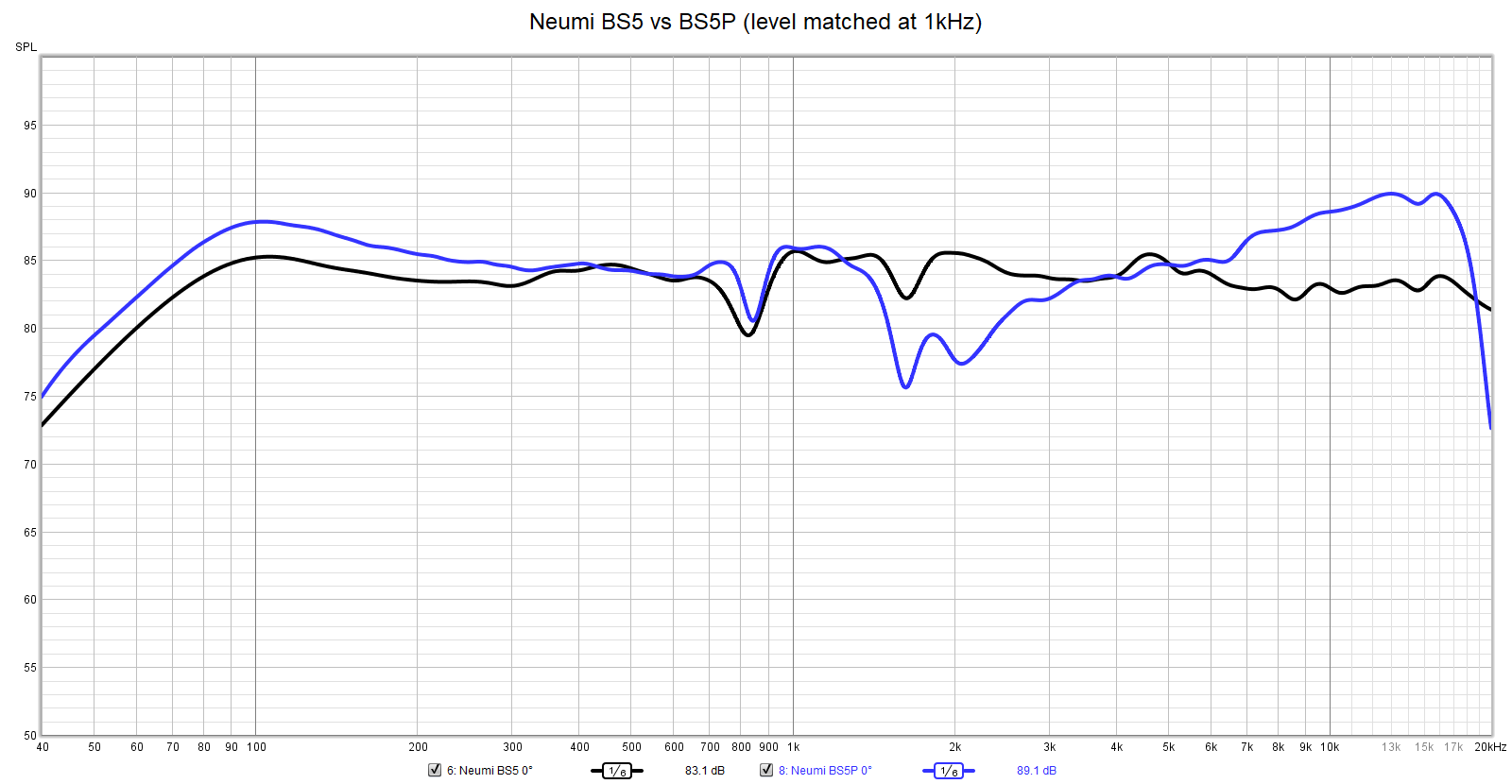
In-Room Measurements from the Listening Position
Below is the actual measured in-room response (with no DSP correction). This is a spatial average taken over approximately 1 cubic foot. The speakers were placed approximately 1.2m from the front wall (not the cabinets; but the actual wall). The listening position was primarily at 1.5m but for this test I measured the response at two different distances from the speakers.
Black = Predicted In-Room Response from SPIN data
Red = Actual In-Room Measured Response from Main Listening Position at 1.5 meters
Blue = Actual In-Room Measured Response from Main Listening Position at 3.5 meters

As expected, the predicted in-room response and the farfield response (3.5 meter, blue) line up quite well above approximately 500Hz. However, when moving to the nearfield (1.5 meter, red), the high frequency response is accentuated even more above 8kHz, reaching as much as +4dB compared to the farfield response/estimation.
Parting / Random Thoughts
If you want to see the music I use for evaluating speakers subjectively, see my Spotify playlist.
- Subjective listening varied between the nearfield at 1 meter and the farfield at 4 meters. Subjective listening was conducted at 80-95dB at these distances. Higher volumes were done simply to test the output capability in case one wants to try to sit further away.
- The response linearity is all over the place thanks to the “V-curve” shape and the port resonances at ~800Hz and ~1.8kHz. These resonances were also present in the passive version so weren’t necessarily unexpected. However, the V-curve response makes the response of this speaker much further from ideal.
- Very punchy bass at all output levels.
- There is a tendency for this speaker to resonate and hang on to notes in the 100-200Hz region a bit too long.
- Very heightened high frequency content, which is fatiguing when listening long-term, especially at higher volumes.
- Midrange vocals recessed.
- Despite the manufacturer stating “optimized for a smooth frequency response while limiting distortion at high sound levels”, this is not a reference speaker. Furthermore, in my humble opinion, the BS5P is unfortunately a step-down in fidelity from the Neumi BS5 (passive speaker) I reviewed in the past.
- These speakers have very good directivity, outside of the port resonances and therefore should respond well to EQ. In which case, they would make a good option for computer speakers if you can implement EQ to tame the exaggerated bass and highs.
- If you are, however, looking for a speaker with a lot of pizzaz and a lot of hookup options then this is an option for you. That said, I would not necessarily recommend these for TV as the dialogue frequencies are recesses relative to the high and low frequencies.
As stated in the Foreword, this written review is purposely a cliff’s notes version. For more details about the performance (objectively and subjectively) please watch the YouTube video.
Support / Donate
If you like what you see here and want to help me keep it going, please consider donating via the PayPal Contribute button located below. Donations help me pay for new items to test, hardware, miscellaneous items and costs of the site’s server space and bandwidth. All of which I otherwise pay out of pocket. So, if you can help chip in a few bucks, know that it is very much appreciated.
Alternatively, if you are interested in purchasing these speakers, please consider using my Amazon affiliate link below. It yields me a small commission at no additional cost to you and allows me to keep doing what I am doing.
You can also join my Facebook and YouTube pages if you would like to follow along with updates.
